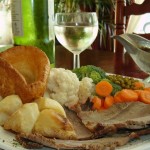 We've known for a while now that a variety of factors can influence what, and how much, people consume.
We've known for a while now that a variety of factors can influence what, and how much, people consume.
For example, eating in a social setting can result in overeating, and so can removing half-empty plates from the table of portions already consumed. And most folks are aware that grocery shopping on an empty stomach often results in more purchases of high calorie foods, as we described here. A new meta-analysis lends credence to these ideas, by combining the data from numerous studies.
Gareth J. Hollands from the University of Cambridge, U.K., and colleagues, examined data from 72 studies that compared at least two groups with respect to their choices of food, alcohol, or tobacco when package, portion or size of tableware dishes and glasses were altered. These studies were published between 1978 and 2013, and 96 percent described experiments related to food consumption. In this study, data from different reports were combined, depending on how the experiments were performed. Thus, more than one analysis was carried out.
The authors examined comparisons from 58 studies (about 6600 participants) and found a small-to-moderate effect of portion, package, individual unit or tableware size on consumption of food. In brief, among both children and adults, exposure to larger sizes increased quantities of food consumed.
Another analysis of data from 10 studies (about 1200 participants) found that larger portion sizes and tableware sizes were associated with greater food consumption by adults, but not by children.
The authors concluded "this review found that people consistently consume more food and drink when offered larger-sized portions, packages or tableware, than when offered smaller-sized versions.
"This suggests that policies and practices that successfully reduce the size, availability and appeal of larger-sized portions, packages, individual units and tableware can contribute to meaningful reductions in the quantities of food (including non-alcoholic beverages) people select and consume in the immediate and short term."
ACSH's senior nutrition fellow, Dr. Ruth Kava, added "it's no secret that tableware has expanded in size over the past few decades. For example, red wine glasses might have held six ounces 30 years, but now they're closer to 16 ounces or more. And surely, one does not have to be a food expert to note that soft drinks, both in bottles and cans, are much larger than they used to be. Thus food and drink purveyors have responded with smaller packages of snack foods and beverages. We hope that consumers get the clue that these size changes are there for a reason and decrease their consumption accordingly."


